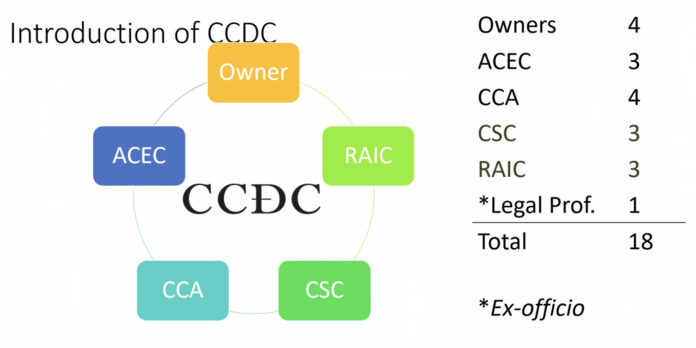Ottawa Construction News staff writer
A new CCDC-2 standard form contract for stipulated price contracts will address some concerns and confusion about the long-established forms, and introduce new features, including a “Ready-for Takeover” project closeout provision.
The standardized contract, introduced this year, will replace the widely-used contract last updated in 2008. It includes new Division 1 language and accommodations for prompt payment and adjudication legislation, says Clive Thurston, the former Ontario General Contractors’ Association (OGCA) president.
Thurston and construction lawyer Geza Banfai (who is a member of the drafting Canadian Construction Documentation Committee – CCDC), outlined the updated contract last week at a virtual workshop co-ordinated by the Ontario Public Buyers Association (OPBA). OPBA represents procurement officials at municipalities and other public agencies throughout the province.
Banfai said the new and previous 2008 contract forms will both be valid until the old form is withdrawn at year’s end.
The CCDC-2 form is the most popular and widely-used construction contract document in Canada, with about 15,000 uses per year. (Users need to purchase a seal from the CCDC to comply with copyright law.)
“We’re very unique in Canada,” Thurston said. “We’re one of the very few jurisdictions that has standardized contracts, as well as a law system designed for the procurement of construction.”
CCDC has 18 members, including four representing owners, three from the Association of Consulting Engineers of Canada (ACEC), four from the Canadian Construction Association (CCA) representing general contractors and sub-trades, three from Construction Specifications Canada (CSC) and three representing the Royal Architectural Institute of Canada (RAIC). Banfai serves as the ex-officio legal representative. CCDC holds four three-day meetings annually plus other meetings as necessary.
Thurston said the one of the most noticeable changes in the new CCDC-2 document is the “Ready-for-Takeover” provision.
This provision covers aspects of the project that need to be resolved after substantial performance is achieved. In Ontario, substantial performance occurs at a point when approximately 97 per cent of the project’s value is completed – but there are still unfinished aspects and these have often been outlined contractually in supplemental conditions in the older CCDC document.
The revised contract says “the prerequisites for attaining Ready-for-Takeover of the Work are limited to the following”:
- The consultant has certified or verified the substantial performance of the work;
- Evidence of compliance with the requirements for occupancy or occupancy permit as prescribed by the authorities having jurisdiction;
- Final cleaning and waste removal at the time of applying for Ready-for-Takeover as required by the contract documents;
- The delivery to the owner of such operations and maintenance documents reasonably necessary for the immediate operation and maintenance, as required by the contract documents;
- Make available a copy of the as-built drawings completed to date on site;
- Startup, testing required for immediate occupancy, as required by the contract documents;
- Ability to secure access to the work has been provided to the owner, if required by the contract documents; and
- Demonstration and training, as required by the contract documents, is scheduled by the contractor acting reasonably.
Banfai said the Ready-for-Takeover milestone applies to contract time, delay due to stop work order, abeyance for arbitration, insurance provisions, warranty, notice requirement ore indemnifications and waiver of claims.
However, holdback payment remains tied to the substantial performance requirements, not Ready-for-Takeover.
There is a provision for early occupancy of part or the entire building. If the entire building is occupied, the occupancy point becomes the Ready-for-Takeover date; if part of the building is occupied, the provisions apply for the portions that have been occupied. This factor will be especially relevant for warranty claims.
Thurston noted that there can be areas for confusion, which will require additional clarification. For example, if part of a building is partially occupied and it requires an air conditioning unit that serves the entire structure, should the entire warranty “start date” for the air conditioning equipment be the early occupancy date?
Another new contract feature is the introduction of “Division 01 – General Requirements.”
These provisions are included in an editable Word document form – meaning that owners must be careful to ensure the provisions are appropriate for the project, and that the CCDC Division 01 specifications document is not duplicated within another Division 01 that may be contained within the contract specification package.
Division 01 includes references for site documents, submittal schedules, protection of work, cutting and patching, and contract security requirements.
The new standard form contract also makes clear that the obligation to make payment is subject to any payment legislation, which overrides obligations otherwise prescribed by the CCDC 2 – 2020.
The new contract mirrors payment timelines in Ontario’s Construction Act – namely the requirement for the owner to pay within 28 days of submission of a Proper Invoice. As well, if an owner fails to pay upon an adjudication, this is “now a ground for default”.








